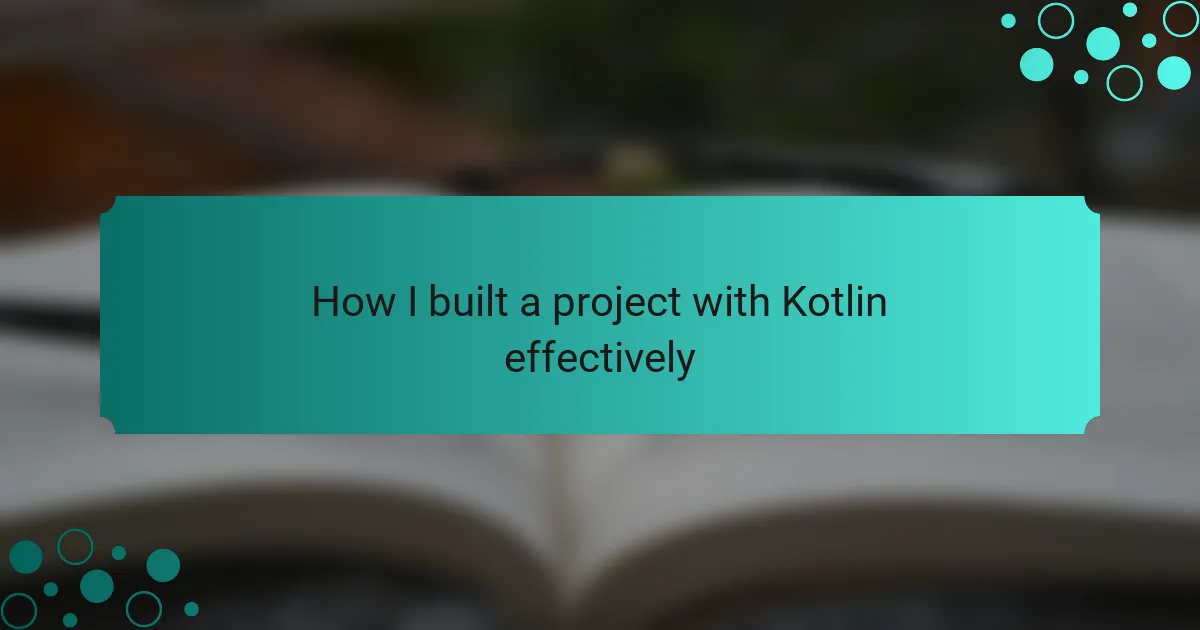Key takeaways
- Kotlin features concise syntax and built-in null safety, significantly reducing errors and improving code readability and maintenance.
- The ability to use extension functions allows developers to enhance existing classes without altering their original code.
- Coroutines simplify asynchronous programming, making it easier to write clean and efficient code that maintains sequential logic.
- Using tools like IntelliJ IDEA and version control with Git enhances productivity and collaboration in Kotlin development.
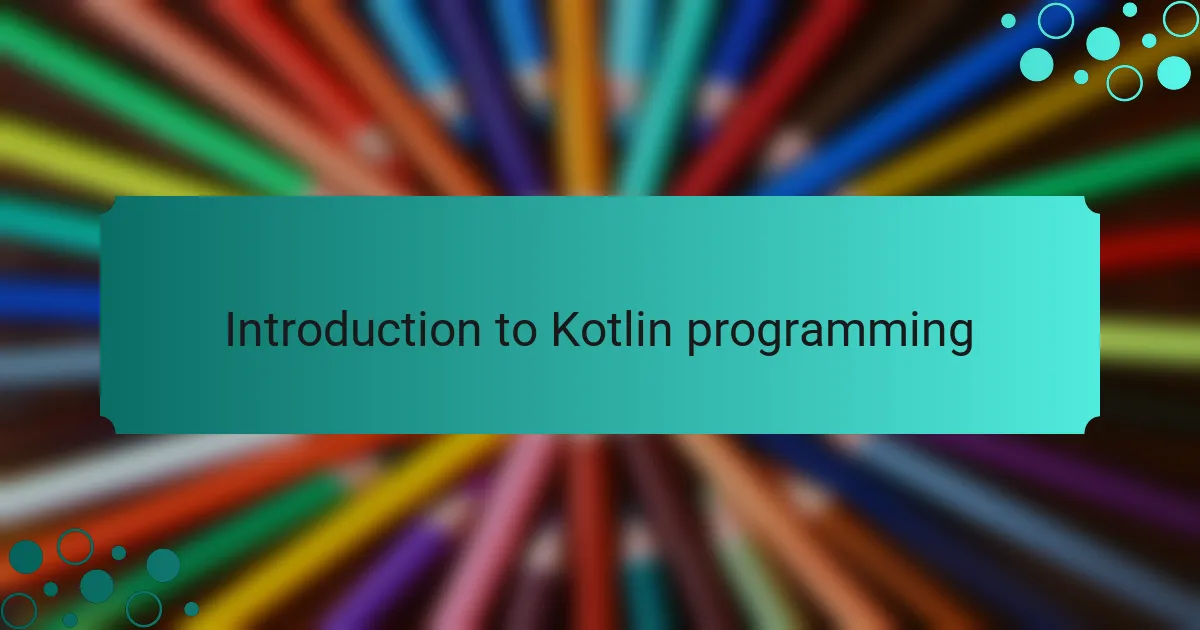
Introduction to Kotlin programming
Kotlin is a modern programming language that has rapidly gained popularity, especially for Android development. When I first ventured into Kotlin, I was impressed by its concise syntax and the way it seamlessly integrates with existing Java code. It felt like a breath of fresh air compared to the verbosity of Java, making coding not just efficient, but truly enjoyable.
What struck me the most was Kotlin’s emphasis on safety, especially with its null safety feature that helped prevent common programming errors. As someone who has often faced frustrating crashes due to null pointer exceptions, this aspect alone felt like a game-changer. I found that the more I worked with Kotlin, the more confident I became in writing clean and bug-free code.
Here’s a quick comparison of Kotlin and Java, highlighting some key differences that stand out to programmers like us who are looking for a modern approach:
| Feature | Kotlin | Java |
|---|---|---|
| Syntax | Concise and expressive | Verbose and boilerplate-heavy |
| Null Safety | Built-in support to avoid null pointer exceptions | No intrinsic null safety |
| Extension Functions | Allows adding new functionalities to existing classes | Not supported |
| Interoperability | Fully interoperable with Java | Compatible with Kotlin, but may require extra effort |

Benefits of using Kotlin
Kotlin’s concise syntax is one of its most significant benefits. I remember the first time I wrote a function in Kotlin; it felt like every line flowed naturally. It’s liberating to write less code and achieve the same functionality, which not only speeds up development but also makes maintenance a breeze.
Another standout feature for me has been Kotlin’s null safety. I can’t stress enough how many late-night debugging sessions I’ve had due to null pointer exceptions in Java. With Kotlin, I felt an immediate sense of relief, knowing that many potential errors were mitigated right from the start. This feature genuinely changed how I approach coding, allowing me to focus on logic rather than frequent crash prevention.
Additionally, Kotlin’s support for extension functions has been a game changer. Being able to add custom methods to classes without modifying their source code opened up new avenues for creativity in my projects. Have you ever wished you could just enhance a library or an API? With Kotlin, I found that I could do just that, making my development process not only more efficient but also more enjoyable.
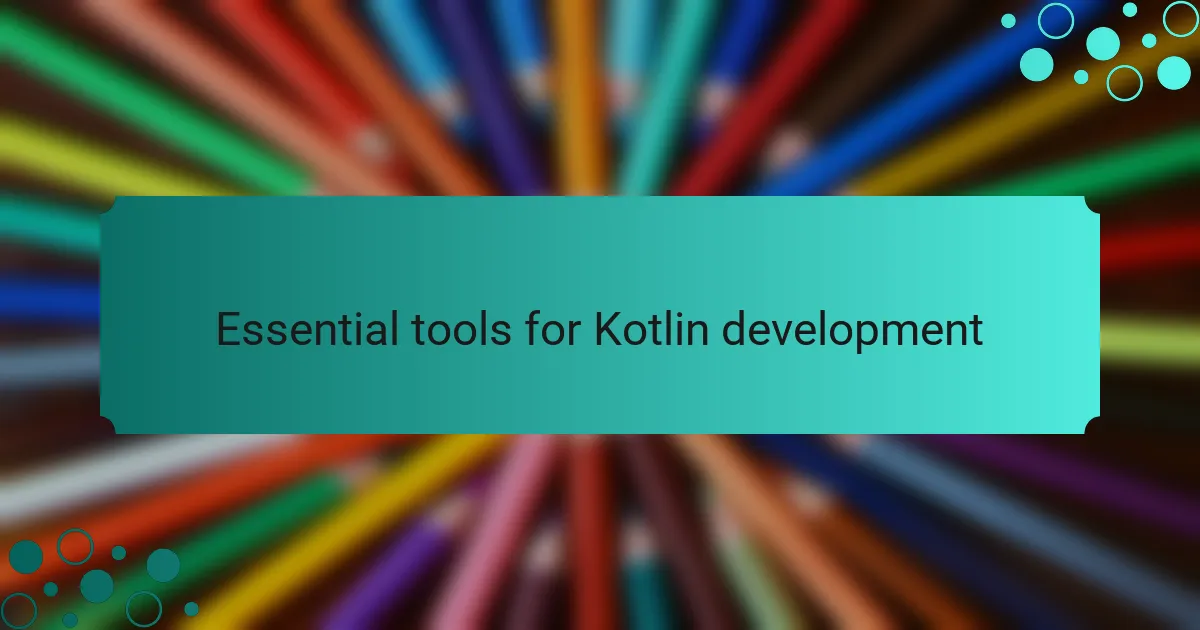
Essential tools for Kotlin development
When I first started building projects with Kotlin, I quickly realized that having the right tools can make a significant difference in productivity and overall experience. One tool that stood out for me was IntelliJ IDEA. Its robust features and seamless integration with Kotlin made coding feel more intuitive, eliminating unnecessary barriers. I remember feeling an exhilarating sense of accomplishment when I first ran my code without any errors, thanks to the exceptional debugging tools at my disposal.
Another essential aspect of Kotlin development is version control. I highly recommend using Git alongside a platform like GitHub. Not only does it help keep your project organized, but it also fosters collaboration, something that I found incredibly rewarding. Being able to look back at my commit history reminded me of the growth I experienced throughout the project.
Essential Tools for Kotlin Development:
- IntelliJ IDEA: A powerful IDE with excellent support for Kotlin.
- Kotlin Plugin: Enhances productivity within IntelliJ for Kotlin-specific features.
- Gradle: A build automation tool that simplifies project management.
- Git & GitHub: For version control and collaboration.
- Kotlinx.serialization: A library for serializing and deserializing data, making it easier to handle JSON.
- JUnit: A framework for testing, which helps ensure your code is reliable and well-functioning.
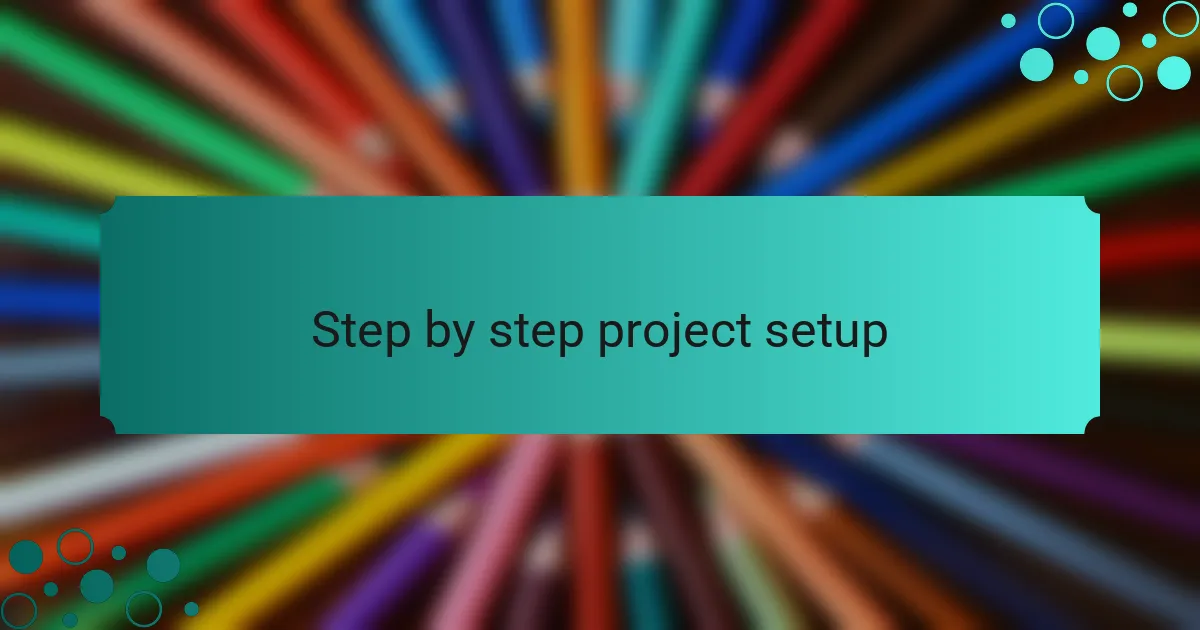
Step by step project setup
When setting up a Kotlin project, the first step is to choose your development environment. I remember the excitement I felt when I installed IntelliJ IDEA and set it up for Kotlin development. It was astonishing how quickly I could start a new project by using the built-in project wizard. Just select “Kotlin” and you’re off to the races!
Next, I always pay attention to the project structure. This step is crucial for keeping everything organized as the project grows. Initially, I kept my source files in the src/main/kotlin directory, which is the standard for Kotlin projects. Having a clear structure saved me a lot of headaches later when debugging or adding new features. Do you have a filing system that works for you?
Last but not least, configuring the build system is something I’ve learned to prioritize. When I first tackled Gradle, honestly, it felt overwhelming. But once I integrated it into my project, the benefits were undeniable. I could define dependencies easily and handle library versions without much fuss. I distinctly remember the relief when I got my first Gradle build to run successfully—it felt like a small victory that set the tone for the entire project.

Key features of Kotlin for projects
Kotlin is packed with features that make it an excellent choice for projects. One feature that stands out to me is its powerful type inference, which automatically deduces types, reducing the clutter in your code. I remember the first time I wrote a function without explicitly declaring types; it felt like I was finally free to focus more on logic rather than syntax. Isn’t it refreshing to feel that coding can be about problem-solving rather than just typing?
Another remarkable aspect is Kotlin’s functional programming capabilities. I found that using higher-order functions and lambda expressions really transformed my approach to building applications. When I used them to handle collections efficiently, it struck me how much cleaner and more expressive the code became. Have you ever written a chunk of code and realized it resembled poetry? That’s how I felt using these features!
Kotlin also shines in its ability to simplify asynchronous programming with coroutines. I remember grappling with callbacks in previous languages and the chaos that ensued. Now, with coroutines, I could write asynchronous code that looked and behaved like sequential code, making my life so much easier. It’s like removing a heavy weight from your shoulders, don’t you think? This feature has not only boosted my productivity but also significantly improved code readability.

My personal project experience
My experience working on a personal project with Kotlin was nothing short of transformative. I decided to build a simple task management app, and as I started coding, I was immediately struck by the elegance of the language. Each line felt purposeful, and I found myself enjoying the process much more than I anticipated. Have you ever had a project where everything just clicked? That’s exactly how I felt, and it drove me to explore Kotlin’s capabilities further.
I vividly recall a moment of frustration when I tackled asynchronous programming. In my previous projects, dealing with callbacks felt overwhelmingly cumbersome. But once I delved into Kotlin coroutines, everything changed. It was like the clouds parted, revealing a clear path forward. Writing sequential-looking asynchronous code was a revelation, alleviating so much of the stress that had bogged me down in the past. Isn’t it amazing how a single feature can shift your entire coding experience?
As I continued to develop my app, I was particularly pleased with how straightforward it was to implement testing with JUnit. I distinctly remember the first time I wrote a test that actually passed on the first try. That feeling of accomplishment was invigorating! It reinforced the importance of writing reliable code and gave me more confidence as I pushed my project further. How rewarding is it to see your efforts validated through successful tests? Each success kept me motivated and eager to dive deeper into Kotlin’s rich feature set.
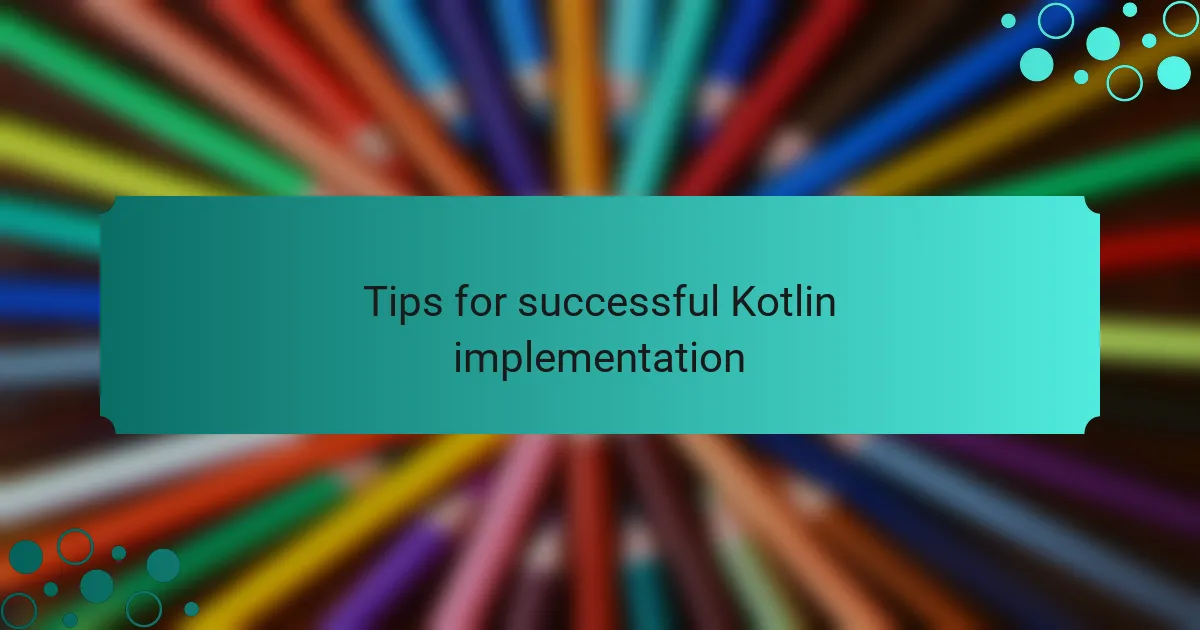
Tips for successful Kotlin implementation
When implementing Kotlin effectively in your project, one of my top tips is to embrace its concise syntax. I remember transitioning from Java to Kotlin and feeling relieved at how much easier it was to write clean code. This not only boosted my productivity but also made maintenance a breeze.
Another important strategy is to leverage Kotlin’s powerful features like extension functions and coroutines. I once built a complex asynchronous data-fetching feature using coroutines, and it simplified my code significantly. I found that these features not only enhance readability but also improve the overall performance of the application.
Don’t forget about utilizing Kotlin’s built-in null safety to prevent those pesky null pointer exceptions. I was often frustrated by unexpected crashes due to null references in my earlier projects. Once I adopted Kotlin’s null-safety features, I felt a weight lift off my shoulders, knowing that my code was more robust and less error-prone.
| Kotlin Feature | Benefit |
|---|---|
| Concise Syntax | Reduces boilerplate code and enhances readability |
| Extension Functions | Allows adding new functionality to existing classes without modifying them |
| Coroutines | Simplifies asynchronous programming and improves code performance |
| Null Safety | Prevents null pointer exceptions, making code more reliable |
